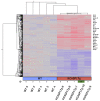Inflammatory Skin Disease Causes Anxiety Symptoms Leading to an Irreversible Course
- PMID: 36983014
- PMCID: PMC10058663
- DOI: 10.3390/ijms24065942
Inflammatory Skin Disease Causes Anxiety Symptoms Leading to an Irreversible Course
Abstract
Intense itching significantly reduces the quality of life, and atopic dermatitis is associated with psychiatric conditions, such as anxiety and depression. Psoriasis, another inflammatory skin disease, is often complicated by psychiatric symptoms, including depression; however, the pathogenesis of these mediating factors is poorly understood. This study used a spontaneous dermatitis mouse model (KCASP1Tg) and evaluated the psychiatric symptoms. We also used Janus kinase (JAK) inhibitors to manage the behaviors. Gene expression analysis and RT-PCR of the cerebral cortex of KCASP1Tg and wild-type (WT) mice were performed to examine differences in mRNA expression. KCASP1Tg mice had lower activity, higher anxiety-like behavior, and abnormal behavior. The mRNA expression of S100a8 and Lipocalin 2 (Lcn2) in the brain regions was higher in KCASP1Tg mice. Furthermore, IL-1β stimulation increased Lcn2 mRNA expression in astrocyte cultures. KCASP1Tg mice had predominantly elevated plasma Lcn2 compared to WT mice, which improved with JAK inhibition, but behavioral abnormalities in KCASP1Tg mice did not improve, despite JAK inhibition. In summary, our data revealed that Lcn2 is closely associated with anxiety symptoms, but the anxiety and depression symptoms caused by chronic skin inflammation may be irreversible. This study demonstrated that active control of skin inflammation is essential for preventing anxiety.
Keywords: JAK inhibitor; Lipocalin 2; S100a8; anxiety; atopic dermatitis; cytokine; inflammatory skin; mouse model; psoriasis.
Conflict of interest statement
The authors declare no conflict of interest. The funders had no role in the study design; collection, analyses, or interpretation of data; writing of the manuscript; or decision to publish the results.
Figures






Similar articles
-
Amelioration of Systemic Amyloidosis by Blocking IL-17A and Not by IL-17F, and Arteriosclerosis by Blocking Both IL-17A and IL-17F in an Inflammatory Skin Mouse Model.Int J Mol Sci. 2024 Oct 29;25(21):11617. doi: 10.3390/ijms252111617. Int J Mol Sci. 2024. PMID: 39519167 Free PMC article.
-
Arteriosclerosis Derived from Cutaneous Inflammation Is Ameliorated by the Deletion of IL-17A and IL-17F.Int J Mol Sci. 2023 Mar 12;24(6):5434. doi: 10.3390/ijms24065434. Int J Mol Sci. 2023. PMID: 36982506 Free PMC article.
-
IL-17A Is the Critical Cytokine for Liver and Spleen Amyloidosis in Inflammatory Skin Disease.Int J Mol Sci. 2022 May 20;23(10):5726. doi: 10.3390/ijms23105726. Int J Mol Sci. 2022. PMID: 35628531 Free PMC article.
-
A systematic review on shared biological mechanisms of depression and anxiety in comorbidity with psoriasis, atopic dermatitis, and hidradenitis suppurativa.Eur Psychiatry. 2021 Nov 25;64(1):e71. doi: 10.1192/j.eurpsy.2021.2249. Eur Psychiatry. 2021. PMID: 34819201 Free PMC article.
-
Innovation in the treatment of atopic dermatitis: Emerging topical and oral Janus kinase inhibitors.Allergol Int. 2022 Jan;71(1):40-46. doi: 10.1016/j.alit.2021.10.004. Epub 2021 Nov 21. Allergol Int. 2022. PMID: 34815171 Review.
Cited by
-
Amelioration of Systemic Amyloidosis by Blocking IL-17A and Not by IL-17F, and Arteriosclerosis by Blocking Both IL-17A and IL-17F in an Inflammatory Skin Mouse Model.Int J Mol Sci. 2024 Oct 29;25(21):11617. doi: 10.3390/ijms252111617. Int J Mol Sci. 2024. PMID: 39519167 Free PMC article.
-
New treatment of pyoderma gangrenosum and hidradenitis suppurativa: A review.J Dermatol. 2024 Feb;51(2):172-179. doi: 10.1111/1346-8138.17031. Epub 2023 Nov 27. J Dermatol. 2024. PMID: 38009911 Free PMC article. Review.
References
-
- Mizutani H., Nishiguchi T., Murakami T. Animal Models of Atopic Dermatitis. Jpn. Med. Assoc. J. 2004;47:501–507. doi: 10.1097/01206501-200807000-00027. - DOI
-
- Kato S., Matsushima Y., Mizutani K., Kawakita F., Fujimoto M., Okada K., Kondo M., Habe K., Suzuki H., Mizutani H., et al. The Stenosis of Cerebral Arteries and Impaired Brain Glucose Uptake by Long-Lasting Inflammatory Cytokine Release from Dermatitis Is Rescued by Anti-IL-1 Therapy. J. Investig. Dermatol. 2018;138:2280–2283. doi: 10.1016/j.jid.2018.04.016. - DOI - PubMed
MeSH terms
Substances
Grants and funding
LinkOut - more resources
Full Text Sources
Molecular Biology Databases
Miscellaneous

